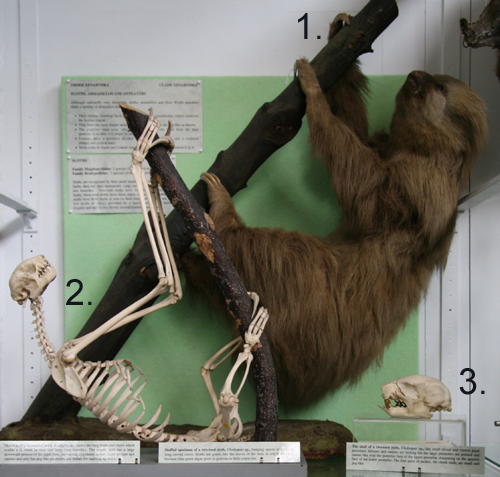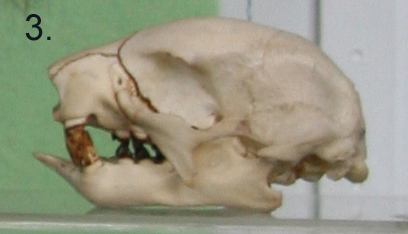
SLOTHS
Family Megalonychidae – 2 species of two-toed sloths.
Family Bradypodidae – 3 species of three-toed sloths.
Sloths are easily recognised by their small heads, round bodies and long limbs with enormously long and curved claws which they use to hang suspended from tree branches. Two-toed sloths have two digits on their fore limbs; three-toed sloths have three digits on their fore limbs. All sloths have three digits or toes on their hind limbs. Sloths live in trees with exposed crowns in lowland and upland tropical forest and are coloured green like the leaves among which they live. The green colour is due to the blue-green algae that grow in grooves in the coarse hairs of the overcoat which grows over the undercoat of short fine hairs.

1. Stuffed specimen of a two-toed sloth, Choloepus sp., shows the typical appearance of a sloth hanging upside down by its long curved claws with the coarse coat in which the blue green algae live.
2. Skeleton of a three-toed sloth, Bradypus sp., shows the long limbs and claws which enable it to climb around in trees and hang suspended from branches. The simple skull has a large downward process of the jugal bone, lacks incisors and canines and only has peg-like premolars and molars.
Sloths are selective leaf eaters, eating the leaves of only a few of the plant species available to them. They have large multi-compartmented stomachs containing cellulose-digesting bacteria which digest the leaves. A meal may take a month to digest, the animals descending to the forest floor to defecate once a week. Their very specialised diet provides them with little energy and sloths have very low metabolic rates and low temperatures. They use energy frugally by moving very slowly over limited home ranges. Three-toed sloths regulate their body temperature by ‘basking’ - moving in and out of the sun.
Like other xenarthrans, sloths have simple skulls with incomplete zygomatic arch. They have relatively few teeth; they lack canines and incisors, and only possess five upper and four lower molars. The uniform peg-like cheek teeth have open roots, that allow for continuous growth. The teeth are used to mash up their food.

3. The skull of a two-toed sloth, Choloepus sp., has small dorsal and ventral jugal processes. Incisors and canines are lacking but the large premolars are pointed and canine-like; the posterior face of the upper premolar sharpens on the anterior face of the lower premolar. The four pairs of molars, the cheek teeth, are small and peg-like.






